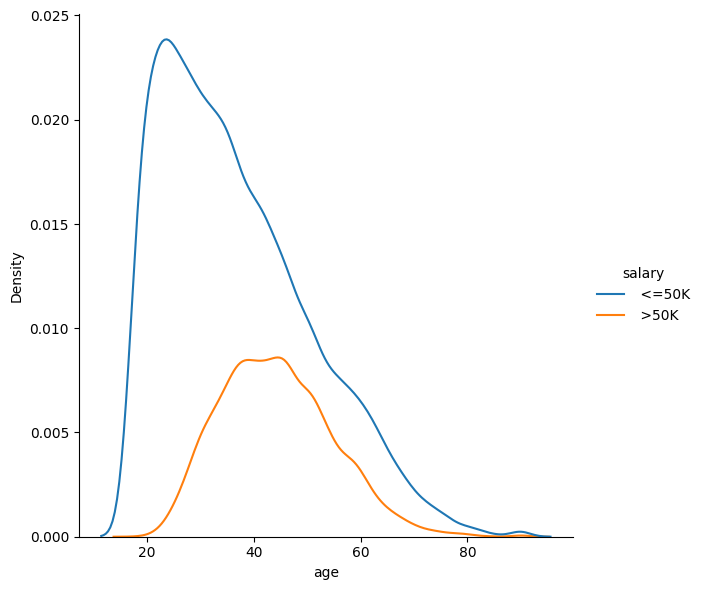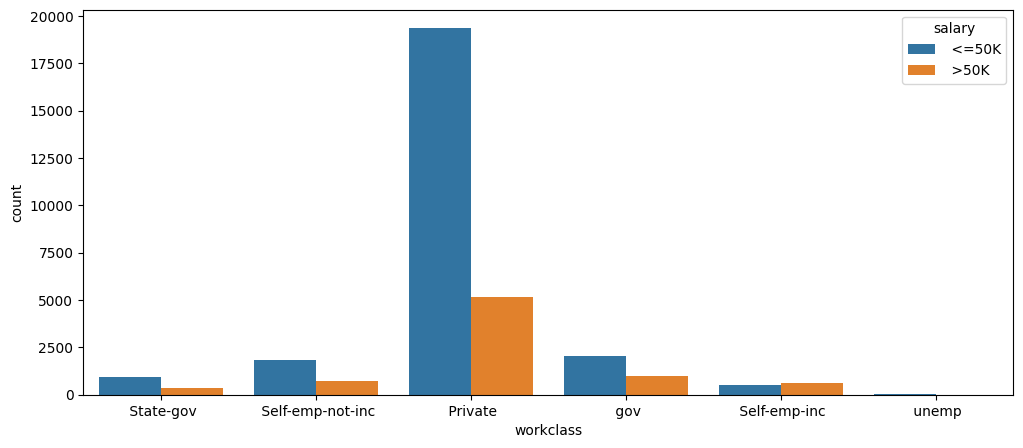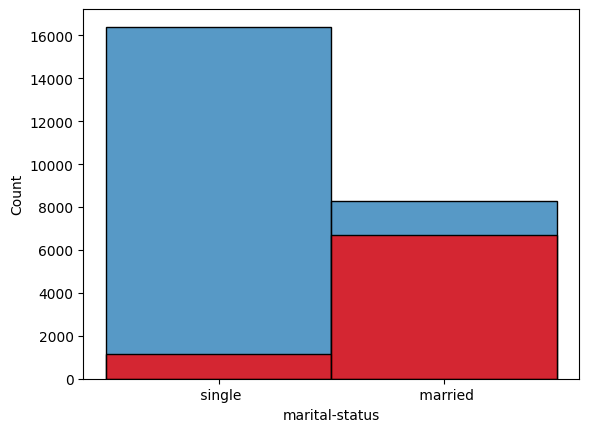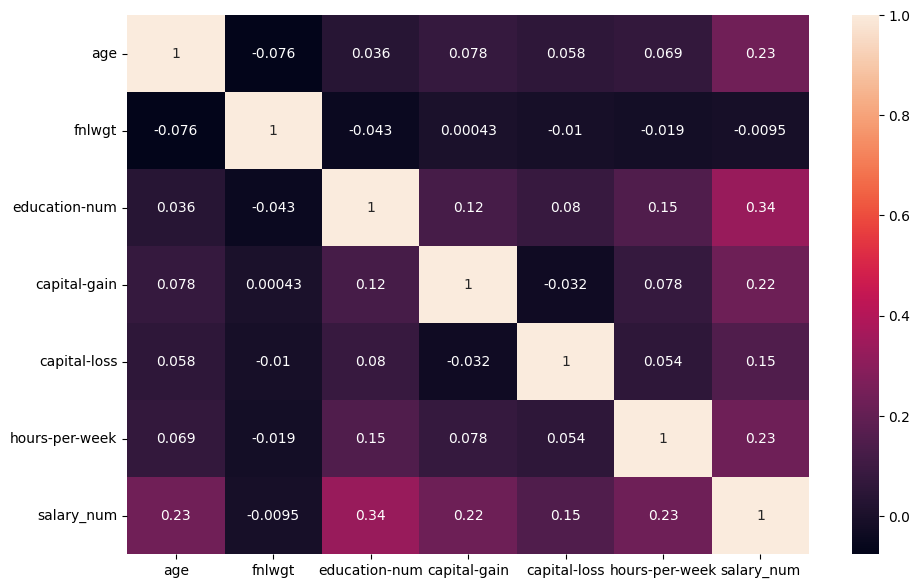Salary Classification By Using Decision Tree
Contents
Salary Classification By Using Decision Tree#
Author: Kevin Xu
Course Project, UC Irvine, Math 10, F22
Introduction#
I chose this dataset that counted people’s age, education level, situation in the household, type of company they work for, and whether their salary was over 50k, etc. The purpose of this project is to classify each person’s salary is whether higher than 50k by their age, education level, family situation, etc. I think this will help each employee plan their career path better and will also help company to better distribute the salary. And there are four steps in my project. First I will use pandas to clean the data, and second I will plot a lot of interesting chart to visualize my data to help people learn more about my data. Third, I will build the decision tree, and the last step is to use train_test_split to test the accuracy. And my project is supervised learning in machine learning, and I did it with classification.
Introduce Data#
import pandas as pd
import numpy as np
from sklearn.preprocessing import LabelEncoder
import seaborn as sns
import altair as alt
import seaborn as sns
from sklearn.cluster import KMeans
import matplotlib.pyplot as plt
from sklearn.tree import DecisionTreeClassifier
from sklearn.model_selection import train_test_split
from sklearn.tree import plot_tree
df = pd.read_csv("salary.csv")
df
| age | workclass | fnlwgt | education | education-num | marital-status | occupation | relationship | race | sex | capital-gain | capital-loss | hours-per-week | native-country | salary | |
|---|---|---|---|---|---|---|---|---|---|---|---|---|---|---|---|
| 0 | 39 | State-gov | 77516 | Bachelors | 13 | Never-married | Adm-clerical | Not-in-family | White | Male | 2174 | 0 | 40 | United-States | <=50K |
| 1 | 50 | Self-emp-not-inc | 83311 | Bachelors | 13 | Married-civ-spouse | Exec-managerial | Husband | White | Male | 0 | 0 | 13 | United-States | <=50K |
| 2 | 38 | Private | 215646 | HS-grad | 9 | Divorced | Handlers-cleaners | Not-in-family | White | Male | 0 | 0 | 40 | United-States | <=50K |
| 3 | 53 | Private | 234721 | 11th | 7 | Married-civ-spouse | Handlers-cleaners | Husband | Black | Male | 0 | 0 | 40 | United-States | <=50K |
| 4 | 28 | Private | 338409 | Bachelors | 13 | Married-civ-spouse | Prof-specialty | Wife | Black | Female | 0 | 0 | 40 | Cuba | <=50K |
| ... | ... | ... | ... | ... | ... | ... | ... | ... | ... | ... | ... | ... | ... | ... | ... |
| 32556 | 27 | Private | 257302 | Assoc-acdm | 12 | Married-civ-spouse | Tech-support | Wife | White | Female | 0 | 0 | 38 | United-States | <=50K |
| 32557 | 40 | Private | 154374 | HS-grad | 9 | Married-civ-spouse | Machine-op-inspct | Husband | White | Male | 0 | 0 | 40 | United-States | >50K |
| 32558 | 58 | Private | 151910 | HS-grad | 9 | Widowed | Adm-clerical | Unmarried | White | Female | 0 | 0 | 40 | United-States | <=50K |
| 32559 | 22 | Private | 201490 | HS-grad | 9 | Never-married | Adm-clerical | Own-child | White | Male | 0 | 0 | 20 | United-States | <=50K |
| 32560 | 52 | Self-emp-inc | 287927 | HS-grad | 9 | Married-civ-spouse | Exec-managerial | Wife | White | Female | 15024 | 0 | 40 | United-States | >50K |
32561 rows × 15 columns
Here I introduce my data and import all necessary tools. My data records whether a person’s salary is higher than 50K. This record is analyzed according to many aspects of a person, such as age, workclass, education level, marital status and so on. Here is the full name of each column:
Columns are: age: continuous. workclass: Private, Self-emp-not-inc, Self-emp-inc, Federal-gov, Local-gov, State-gov, Without-pay, Never-worked. fnlwgt: continuous. education: Bachelors, Some-college, 11th, HS-grad, Prof-school, Assoc-acdm, Assoc-voc, 9th, 7th-8th, 12th, Masters, 1st-4th, 10th, Doctorate, 5th-6th, Preschool. education-num: continuous. marital-status: Married-civ-spouse, Divorced, Never-married, Separated, Widowed, Married-spouse-absent, Married-AF-spouse. occupation: Tech-support, Craft-repair, Other-service, Sales, Exec-managerial, Prof-specialty, Handlers-cleaners, Machine-op-inspct, Adm-clerical, Farming-fishing, Transport-moving, Priv-house-serv, Protective-serv, Armed-Forces. relationship: Wife, Own-child, Husband, Not-in-family, Other-relative, Unmarried. race: White, Asian-Pac-Islander, Amer-Indian-Eskimo, Other, Black. sex: Female, Male. capital-gain: continuous. capital-loss: continuous. hours-per-week: continuous. native-country: United-States, Cambodia, England, Puerto-Rico, Canada, Germany, Outlying-US(Guam-USVI-etc), India, Japan, Greece, South, China, Cuba, Iran, Honduras, Philippines, Italy, Poland, Jamaica, Vietnam, Mexico, Portugal, Ireland, France, Dominican-Republic, Laos, Ecuador, Taiwan, Haiti, Columbia, Hungary, Guatemala, Nicaragua, Scotland, Thailand, Yugoslavia, El-Salvador, Trinadad&Tobago, Peru, Hong, Holand-Netherlands. salary: <=50K or >50K
Use Pandas Series to clean Data and then classify Data#
df.dropna()
df.duplicated().sum()
df.drop_duplicates(keep = 'first' , inplace=True)
for loc in df.columns:
print(df[loc].value_counts())
36 898
31 888
34 886
23 876
35 875
...
83 6
85 3
88 3
86 1
87 1
Name: age, Length: 73, dtype: int64
Private 22673
Self-emp-not-inc 2540
Local-gov 2093
? 1836
State-gov 1298
Self-emp-inc 1116
Federal-gov 960
Without-pay 14
Never-worked 7
Name: workclass, dtype: int64
164190 13
123011 13
203488 13
121124 12
148995 12
..
209392 1
218551 1
201204 1
362999 1
145522 1
Name: fnlwgt, Length: 21648, dtype: int64
HS-grad 10494
Some-college 7282
Bachelors 5353
Masters 1722
Assoc-voc 1382
11th 1175
Assoc-acdm 1067
10th 933
7th-8th 645
Prof-school 576
9th 514
12th 433
Doctorate 413
5th-6th 332
1st-4th 166
Preschool 50
Name: education, dtype: int64
9 10494
10 7282
13 5353
14 1722
11 1382
7 1175
12 1067
6 933
4 645
15 576
5 514
8 433
16 413
3 332
2 166
1 50
Name: education-num, dtype: int64
Married-civ-spouse 14970
Never-married 10667
Divorced 4441
Separated 1025
Widowed 993
Married-spouse-absent 418
Married-AF-spouse 23
Name: marital-status, dtype: int64
Prof-specialty 4136
Craft-repair 4094
Exec-managerial 4065
Adm-clerical 3768
Sales 3650
Other-service 3291
Machine-op-inspct 2000
? 1843
Transport-moving 1597
Handlers-cleaners 1369
Farming-fishing 992
Tech-support 927
Protective-serv 649
Priv-house-serv 147
Armed-Forces 9
Name: occupation, dtype: int64
Husband 13187
Not-in-family 8292
Own-child 5064
Unmarried 3445
Wife 1568
Other-relative 981
Name: relationship, dtype: int64
White 27795
Black 3122
Asian-Pac-Islander 1038
Amer-Indian-Eskimo 311
Other 271
Name: race, dtype: int64
Male 21775
Female 10762
Name: sex, dtype: int64
0 29825
15024 347
7688 284
7298 246
99999 159
...
1639 1
5060 1
6097 1
1455 1
7978 1
Name: capital-gain, Length: 119, dtype: int64
0 31018
1902 202
1977 168
1887 159
1485 51
...
2467 1
1539 1
155 1
2282 1
1411 1
Name: capital-loss, Length: 92, dtype: int64
40 15204
50 2817
45 1823
60 1475
35 1296
...
92 1
74 1
94 1
82 1
87 1
Name: hours-per-week, Length: 94, dtype: int64
United-States 29153
Mexico 639
? 582
Philippines 198
Germany 137
Canada 121
Puerto-Rico 114
El-Salvador 106
India 100
Cuba 95
England 90
Jamaica 81
South 80
China 75
Italy 73
Dominican-Republic 70
Vietnam 67
Japan 62
Guatemala 62
Poland 60
Columbia 59
Taiwan 51
Haiti 44
Iran 43
Portugal 37
Nicaragua 34
Peru 31
France 29
Greece 29
Ecuador 28
Ireland 24
Hong 20
Cambodia 19
Trinadad&Tobago 19
Laos 18
Thailand 18
Yugoslavia 16
Outlying-US(Guam-USVI-etc) 14
Honduras 13
Hungary 13
Scotland 12
Holand-Netherlands 1
Name: native-country, dtype: int64
<=50K 24698
>50K 7839
Name: salary, dtype: int64
First I want to drop those missing values and then I want to drop those duplicate rows and remain the first one, also I want to use value.counts() to count the values in columns, after I count the value, I find that there are many question marks in columns “workclass”,”occupation”,”native-country”, and I want to replace those question marks with the most frequent value in each columns.
df['workclass'] = df['workclass'].str.replace('?', 'Private' )
df['occupation'] = df['occupation'].str.replace('?', 'Prof-specialty' )
df['native-country'] = df['native-country'].str.replace('?', 'United-States' )
/shared-libs/python3.7/py-core/lib/python3.7/site-packages/ipykernel_launcher.py:1: FutureWarning: The default value of regex will change from True to False in a future version. In addition, single character regular expressions will*not* be treated as literal strings when regex=True.
"""Entry point for launching an IPython kernel.
/shared-libs/python3.7/py-core/lib/python3.7/site-packages/ipykernel_launcher.py:2: FutureWarning: The default value of regex will change from True to False in a future version. In addition, single character regular expressions will*not* be treated as literal strings when regex=True.
/shared-libs/python3.7/py-core/lib/python3.7/site-packages/ipykernel_launcher.py:3: FutureWarning: The default value of regex will change from True to False in a future version. In addition, single character regular expressions will*not* be treated as literal strings when regex=True.
This is separate from the ipykernel package so we can avoid doing imports until
After I finished replacing question marks, I found that there were many different values in many columns, which was not conducive for me to do data visualization, so I needed to classify some different values according to my needs. For example, I will divide workclass into four categories and education into five categories. I only classify three columns because I need to use other columns to make charts.
df["workclass"].replace(["Self-emp-not-inc","Self-emp-inc"],"self-emp",inplace = True)
df["workclass"].replace(["Federal-gov","Local-gov"],"gov",inplace = True,regex = True)
df["workclass"].replace(["Without-pay","Never-worked"],"unemp",inplace=True,regex=True)
df['education'].replace(['Preschool', '1st-4th', '5th-6th', '7th-8th', '9th','10th', '11th', '12th','HS-grad'], 'lower' ,inplace = True , regex = True)
df['education'].replace(['Assoc-voc', 'Assoc-acdm', 'Prof-school', 'Some-college'], 'medium' , inplace = True , regex = True)
df['marital-status'].replace(['Married-civ-spouse', 'Married-AF-spouse'], 'married' , inplace=True , regex = True)
df['marital-status'].replace(['Divorced', 'Separated','Widowed', 'Married-spouse-absent' , 'Never-married'] ,"single",inplace = True,regex=True)
Data visualization#
In order to better understand the data, I make a lot of interesting charts
alt.Chart(df.sample(5000)).mark_bar().encode(
x = alt.X("education",scale = alt.Scale(zero=False)),
y=alt.Y("fnlwgt",scale=alt.Scale(zero=False)),
color = "salary"
).facet(
"sex"
)
alt.Chart(df.sample(5000)).mark_bar().encode(
x=alt.X('count()', stack="normalize"),
y='education-num',
color='salary'
).facet(
"sex"
)
Here I make two charts.Since Chart only allows 5000 rows, so we can use 5000 random rows from df, In the chart above, I use salary to mark the color and facet to divide the chart into male and female. As we can see, a higher degree means you are more likely to earn more than 50k, and almost all doctoral degrees pay more than 50k. But for women, wages are generally lower than for men.
sns.displot(data=df, x="age", hue="salary", kind="kde", height=6, aspect=1)
<seaborn.axisgrid.FacetGrid at 0x7f17b8401950>

alt.Chart(df.sample(5000)).mark_point().encode(
x="age",
y='fnlwgt',
color='salary',
tooltip='education-num'
).facet(
"sex"
).interactive()
Here I make two charts one is by using seaborn and the other one is by using altair, and also the second chart is interactive chart.As we can see from the charts, a large number of people get a salary of more than 50k when they are between 20 and 40 years old, but the number begins to decline after the age of 40
plt.figure(figsize=(12,5))
sns.countplot(data =df , x = 'workclass', hue = 'salary')
plt.show()

According to the bar graph, we can analyze that there are more people working in private enterprises, but from the proportion of count people, I think self-employees are more likely to get a salary of more than 50k
for i in df['native-country'] :
if i != ' United-States':
df['native-country'].replace([i] , 'Others' , inplace = True)
plt.pie(df['native-country'].value_counts() , labels = ['US' ,'Others'] , autopct = '%0.2f')
plt.show()

Here I classiy native-country columns to two variables in order to make a better pie. chart. From the pie chart, we can see that most of the data come from United States, So I think this data is not representative, we can ignore the impression of regions for a moment, we can consider all regions as the United States
encoder = LabelEncoder()
df["salary_num"] = df["salary"]
df['salary_num'] = encoder.fit_transform(df['salary_num'])
sns.histplot(df[df['salary_num'] ==0]['marital-status'])
sns.histplot(df[df['salary_num'] ==1]['marital-status'] , color='red')
<AxesSubplot:xlabel='marital-status', ylabel='Count'>

I use laberencoder to mark salary to 0 and 1, so it is easier for me to make the chart. And I make a new column salary_num here becasue I need to drop this column when I use train_test_split. From the Chart we can see that, most of married people earn more than 50k. I use seaborn to make this chart, because I think by using this method we can see more clear.
sns.kdeplot(data=df, x='hours-per-week', hue='salary')
<AxesSubplot:xlabel='hours-per-week', ylabel='Density'>

Because of laws, most of people work 40 hours a week, so this is real common.
plt.figure(figsize=(11,7))
sns.heatmap(df.corr(),annot=True)
plt.show()

The heat map looks good.
Decison Tree Classifier#
encoder = LabelEncoder()
df = df.drop(["salary_num"],axis =1)
df['sex'] = encoder.fit_transform(df['sex'])
df['workclass'] = encoder.fit_transform(df["workclass"])
df["marital-status"] = encoder.fit_transform(df["marital-status"])
df["race"] = encoder.fit_transform(df["race"])
df["education"] = encoder.fit_transform(df["education"])
df["occupation"] = encoder.fit_transform(df["occupation"])
df["native-country"] = encoder.fit_transform(df["native-country"])
df["relationship"] = encoder.fit_transform(df["relationship"])
Here, we all know that we need to convert string values to integer values to divide the data and build trees. So here I use laberEncoder to convert my data. And I will post the web link in reference.
input_cols = [c for c in df.columns if c != "salary"]
X = df[input_cols]
y = df["salary"]
X_train,X_test,y_train,y_test = train_test_split(X,y,train_size=0.9,random_state=0)
This step is used to split the data, I want to set “salary” column to y and others to X. And I use 90% of the train_size
clf = DecisionTreeClassifier(max_leaf_nodes=30, max_depth= 20)
clf.fit(X_train,y_train)
fig = plt.figure(figsize=(20,10))
_=plot_tree(clf,
feature_names=clf.feature_names_in_,
class_names=clf.classes_,
filled=True)

This step is used to build my decision tree. If there is a new person, we can go through this decision tree to classify his condition and finally get his salary whether it is above 50k or below 50k
pd.Series(clf.feature_importances_,index=clf.feature_names_in_).sort_values(ascending = True)
workclass 0.000000
relationship 0.000000
race 0.000000
sex 0.000000
native-country 0.000000
fnlwgt 0.003259
occupation 0.004738
education 0.013617
hours-per-week 0.027949
age 0.035311
capital-loss 0.056571
capital-gain 0.205799
education-num 0.221222
marital-status 0.431533
dtype: float64
This step is to rank feature importance.
print(clf.score(X_train,y_train))
print(clf.score(X_test,y_test))
accuracy = clf.score(X_test,y_test)*100
f"Accuracy on Test Data : {accuracy} %."
0.8570501656251067
0.8607867240319607
'Accuracy on Test Data : 86.07867240319607 %.'
Here I print train and test accuaracy by using f-string, and the result seems good.
Summary#
Either summarize what you did, or summarize the results. Maybe 3 sentences.
In my project, I first clean the data, and then I did the data visualization. Then I builed decision tree, after that I test the accuracy. According to the decision tree I made, if there is a new person, we can classify him according to his different conditions and eventually we can determine whether his salary will be higher than 50k.
References#
Your code above should include references. Here is some additional space for references.
What is the source of your dataset(s)?
Dataset source: https://www.kaggle.com/datasets/ayessa/salary-prediction-classification
List any other references that you found helpful.
LabelEncoder: https://scikit-learn.org/stable/modules/generated/sklearn.preprocessing.LabelEncoder.html heatmap : https://www.geeksforgeeks.org/display-the-pandas-dataframe-in-heatmap-style/ seaborn: https://www.section.io/engineering-education/seaborn-tutorial/
Submission#
Using the Share button at the top right, enable Comment privileges for anyone with a link to the project. Then submit that link on Canvas.

